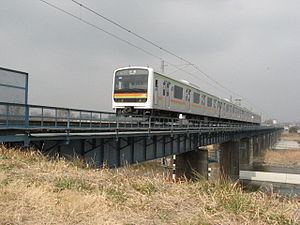Native name 八高線 Stations 23 | Type Heavy rail Opened 1931 | |
 | ||
Terminis | ||
The Hachikō Line (八高線, Hachikō-sen) is a 92.0 km regional railway line owned and operated by East Japan Railway Company (JR East). It is located within Tokyo, Saitama, and Gunma Prefectures in Japan. It connects Hachiōji Station in Hachiōji, Tokyo with Kuragano Station in Takasaki, Gunma Prefecture.
Contents
Services
Komagawa Station in Hidaka, Saitama is the boundary point between two distinct sections. The southern section from Hachiōji to Komagawa is electrified at 1,500 V DC. Some trains terminate at Komagawa, while others continue over the Kawagoe Line to Kawagoe Station. A few trains leave the Hachikō Line at Haijima Station, entering the Ōme Line and terminating at Tokyo Station.
The non-electrified northern section connects Komagawa with Kuragano. All trains continue on the Takasaki Line to Takasaki, where transfer to the Jōetsu Shinkansen is available. There are no through services connecting the southern and northern halves of the line.
The Hachikō Line takes the first kanji of its name from the first character of Hachiōji (八王子) and the second kanji from the first character of Takasaki (高崎).
Stations
Rolling stock
Rolling stock previously used
History
The first section of the line, named the Hachiko North Line (八高北線), opened from Kuragano to Kodama on 1 July 1931, followed by the section from Hachioji to Higashi-Hanno, named the Hachiko South Line (八高南線), on 10 December 1931. The Hachiko North Line was extended southward from Kodama to Yorii on 25 January 1933, and the Hachiko South Line was extended northward from Higashi-Hanno to Ogose on 15 April 1933. The Hachiko South Line was further extended northward from Ogose to Ogawamachi on 24 March 1934, and the last section between Ogawamachi and Yorii opened on 6 October 1934, connecting the north and south sections, and completing the entire line, which became known simply as the Hachiko Line.
All passenger operations were switch from steam haulage to electric trains from 20 November 1958.
CTC signalling was commissioned over the entire line from 27 February 1985. On 1 April 1987, with the privatization and splitting of Japanese National Railways (JNR), the Hachiko Line was transferred to the ownership of JR East.
From 16 March 1996, the Hachioji to Komagawa section was electrified at 1,500 V DC from 16 March 1996, and services on the non-electrified section north of Komagawa to and from Takasaki were operated separately as wanman driver only operation services using KiHa 110 series DMUs.
Former connecting lines
Accidents
In 1945, a head-on collision at the Tamagawa bridge resulted in 105 fatalities.
The Hachiko Line derailment in 1947 is Japan's worst rail accident since World War II in terms of fatalities.
